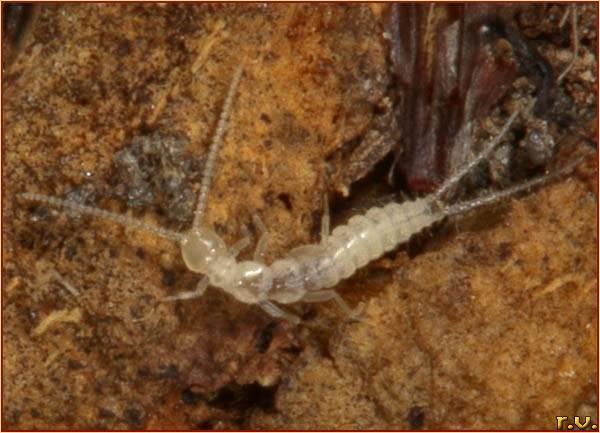Taxonomic classification [1]
• Regnum: Fossil
• Phylum: Arthropods (ARTHROPODA)
• Subphylum: six-legged (Hexapoda)
• Class: Entognath
• Ordo: Diplura
• Subordo: Rhabdura
• Superfamilia: Campodeoidea
• Family: Campodeidae
• Genus Campodea
Species: Campodea fragilis
6 families belong here.
Distribution and habitat
Diplura organisms are primitive, ancient insects scale. The Campodeidae family spread all over the whole earth. Ground-dwelling arthropods, often occur in moist soil, decaying leaves, under wet wood, and stones. They avoid light. Campodeidae live also in caves [1].
Morphology, structure
2−10 mm long. 11 abdomen segment with Cerco at the end. It is long threadlike, or short and curly plier. Head rounded, or elongated, long antennae, jointed like pearls. Chewing mouth held in the retracted pod. Nutrition quenching. Mouthpiece "entotrophok" because gum and jaw are not connected to the head joint outer wall than the other insects, but the interior is deep in the head, so that only the its end go out. Lower lips are largely fused to the head wall of the adjacent parts [1]. The point and the compound eyes are absent [2]. All Diplura has 3 segmented thorax lake, and six legs. Nutrition Different foods is a decaying waste, animal and plant materials. Malpighian vessels, is often lacking. The breathing is through trachea and the addition of fine wines ventral thin bags, which located on the belly side of the thorax segments. Very humid air the blood grows them, so they appears like blister [3]. The omnivores tail is fiber-like, the predators have curly Cerco [2].
Reproduction
There is an orifice at the end of sternit of the 8th bdomen segment. Males place sperm pods near the females hatchway. Their eggs in underground chambers in the wall put themselves created. Preserve and protect certain species. Sometimes there is cannibalism. The larvas are whole segmented. The larvae and adults throw their skin 30 times of their lives. Live for several years [1].
Role in the ecosystem
By man is not an endangered species.
[1.] http://mek.niif.hu/03400/03408/html/2639.html
[2.] http://hu.shvoong.com/exact-sciences/1715770-%C3%B3rai-jegyzet%C3%A1llatrendszertan1/#ixzz1KoYRzNr1
[3.] http://torokjul.web.elte.hu/hexapoda-parainsecta%20jo.pdf
